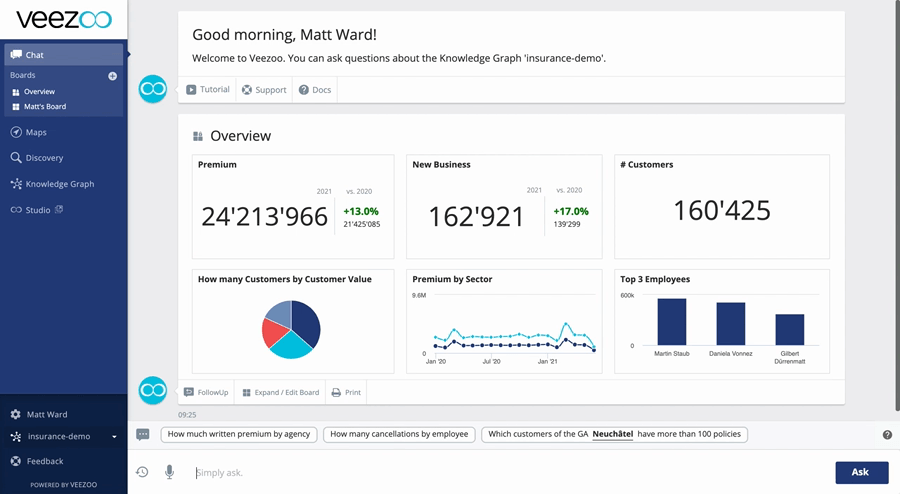The 5 Crucial Keys to Create a Data-First Company Culture
Data is the new oil and artificial intelligence is the new electricity upon which business empires are built. Today, every company HAS TO be a tech company or face obsolescence as more and more forward-thinking organizations follow Silicon Valley’s lead in embracing the value of data.

But becoming a data-first company and building a culture of creative innovation and data-driven insights and actions is not an easy task. The truth is, to get the most out of your data and set your company up for future success amidst increasingly sophisticated, data-driven competition requires serious investment and buy-in at every level of the organization, from upper management to your everyday employee.
Luckily, with a little foresight, a concerted effort (and perhaps an innovatively simple, employee-enabling data analytics tool like Veezoo) it is entirely doable, even if it seems like an impossibly large challenge.
The Keys to a Data-Driven Company Culture:
1. A data-first culture starts at the top
It should go without saying, but too often, initiatives and corporate “values” are a catchall for things “the employees” should do. But when it comes to leadership, the best way is to lead by example. And when it comes to creating a data-driven company culture, this means having upper management focus on the facts and figures to demonstrate to the organization the importance of making decisions based on insights and experimentation, rather than intuition alone.
Unfortunately, this is not an easy task. It requires every member of the organization, from middle management to the CEO, to be humble and accept when they are proven wrong. Nothing undermines a data-first culture more than arbitrary decisions by the management that are inconsistent with the data and are forced down on the employees anyway.
But it is exactly this, combined with the fear of exposing underperformance or issues within the company to employees and shareholders, that often holds organizations back from experiencing the benefits of a truly open data culture.
2. Data is an organisational asset and needs to be treated this way
When it comes to data, it is crucial that the relevant datasets and sources are properly compiled together, so that better insights can be gleaned. This requires an overarching data infrastructure that not only pulls in product and inventory data, but also syncs with marketing, sales, and finance to provide a complete overview of the business at every critical point.
For instance, it is of limited value to know “Which products sold best during Q1 of 2020?” if you don’t also take into account the ROI on ad spend or the production delays that crippled on time deliveries.
All of this requires a major investment, not only to build out the infrastructure, but also to implement data quality processes and governance and ensure the accuracy, integrity, and security of the troves of data coming into a company’s system daily.
Unfortunately, creating the data-driven architecture and processes needed to power the future of the company isn’t an easily measurable ROI – at least not initially. It takes commitment to move beyond immediate results and departmental budgets to build an enduring asset that the entire organization benefits from.
The problem is, too often resources and data are viewed as owned by specific departments rather than an asset for the collective. This creates friction and inefficiency in the system, forces unnecessary back-and-forths, increases the costs of implementation and can have catastrophic consequences, especially where time is money – which is always the case in business.
Add to that the frequent lack of awareness from upper management on the importance of a data infrastructure, a crowded analytics vendor market that often obfuscate data infrastructure best practices, and an industry of consultants incentivized to solve problems at a slow pace and it is no wonder that many companies struggle to truly profit from the vast potential of their organization’s data.
(Which is just another reason we built Veezoo – to democratize and simplify access to data at all levels of organization.)
3. Succeeding with data comes down to the right tools and processes
Large databases are complex and can quickly get very messy and their success or failure generally comes down to good processes and systems, especially for human-generated data, such as from a CRM.
Salespeople very rarely fill out the CRM with all the relevant information about the customer. There are just too many fields to fill out – it quickly becomes overwhelming and time consuming, distracting them from selling so that they just skip it or quickly type something else. The problem is, when you put garbage in the system, you get garbage out of it, and data quickly becomes useless.
One way to fix this is by creating new metrics on how much data gets filled out, measuring performance on that task, and incentivizing salespeople to achieve a given threshold. Unfortunately, this often backfires when employees start filling out even larger quantities of incorrect data. A better alternative is to limit the amount of information to be filled out by individuals and automate the rest using the right RPA tools. This solution reduces the time spent on data entry significantly while at the same time increasing its quality. Plus, employees prefer it.
In the end, however, it’s not until people start making data-driven decisions and directly seeing their value that they feel motivated to maximize its accuracy and collection. This chicken-and-egg issue only gets accentuated further by complex reporting tools that make getting information out of the data overwhelming.
This is one of the reasons why we built Veezoo – to empower everyday employees to literally ask their data anything and immediately visualise the answers, all without having to wait for the data team to create a new report for you.
Learn more about Veezoo and sign up for your free 14-day trial today. Or, better yet, schedule a call with one of our customer success team for a more detailed look at exactly how Veezoo could help your organization and your employees discover new business insights to boost productivity and profit.
4. Choose your key metrics and align everything with the goals of the business
When it comes to metrics and KPIs, there are two main issues that often arise and hold organizations back from success. The first issue is rather simple: the wrong metrics create incentives.
For instance, a business focused solely on maximizing profit and stock price rather than long term growth inevitably stalls as R&D fails to produce new products and the C-suite cash out their inflated stock options and leave. This plays out at every level of the organization, down to the individual employee, such as a salesperson, who might be incentivized to sell as much as possible without taking into account the customer’s needs. Choosing the correct metrics is an art that needs to be practiced attentively within companies.
The other issue, perhaps even worse than choosing the wrong metrics to optimize, is failing to measure at all. “You can’t manage what you can’t measure.” And failure here can kill employee motivation. As human beings, we like to see the tangible results of our labors. Which is why employee incentives and KPIs should not only be realistic and aligned with those of the organization, but be readily available so individuals can know where they stand.
Data can be incredibly powerful when it is used the right way. But to do so, leadership must define which metrics matter most to the business and align initiatives and incentives accordingly. Anything else is destined to fail.
So, what metrics matter most to your business and how are you tracking them?
5. Enable your entire team to use data – in real time
Traditionally, data was used only by the top management. In the beginning, companies would only talk about financial data, but then real-time inventory and resource planning data came along and became more critical. Nowadays companies measure everything: from every email that gets sent by sales to the mouse clicks of every website visitor. All of which can be very valuable and can assist employees in making the right decisions, but only if it is accessible in some form by all roles within the company.
Therefore, the goal of a data-first culture is not only to motivate people towards the right objectives, but ultimately to get them to enable better decisions faster, making the company more agile and effective. If sales, for instance, is struggling to meet their quarterly goals, procurement needs to make a snap decision on which supplier to go with, or marketing needs up-to-date insights on last month’s ad campaigns before re-upping their budgets, they need those answers now – not in three days when the data team finally has time to deal with their inquiry.
Unfortunately, one of the greatest challenges in company-wide adoption of data-driven behavior is due to the so-called information-complexity trade-off, which either limits the amount of information displayed or the amount of people that can digest that information. For example, a dashboard (or any other display interface, such as this article) needs to be very concise and simple in order to reach as many people as possible. This imposes a limit on the amount of information that can be communicated. On the other hand, if this article needed to pass more raw data and information, it would need to be significantly more complicated/information dense, and thus, limit the number of people that could understand and absorb that information.
Thankfully, new interface paradigms like Google-style search or conversation-based Veezoo break away from this information-complexity trade-off by providing users with information on-demand. This way, those that need deeper insights and further information can always have immediate access, and it is only one search/question away.
No one has time to wait because insights matter in the moment they are needed most and every employee (when given the opportunity) has the potential to uncover new, valuable, company-altering insights from their organization’s data. But to do that, data access needs to be democratized across the organization!
Closing Thoughts
At Veezoo, we believe in the power of data, that great ideas can come from anywhere, and that all employees should be empowered to uncover and leverage data-driven insights – not just those with a technical background.
That’s why we designed Veezoo with versatile simplicity in mind, allowing everyone from the sales and marketing to customer support, finance, and product development to have instant access to the information they need to boost productivity, performance, and profits.
If you believe likewise, and want to get started building your data-first business to enable your team to make better, more data-driven decisions, sign up for our free 14-day trial and connect your data today to start uncovering hidden gems within your organization’s database. Or, if you prefer, schedule a call with our customer success team who can walk you through the process and help determine the ideal use cases and value-adds for you and your industry.
Veezoo in the Cloud
Today, we bring Veezoo to the public in a self-service, cloud version with a subscription model accessible to businesses of all sizes, so we can truly democratize access to information.
You can sign up right now for free, connect your data source like Excel or a SQL database and start asking questions – literally.



